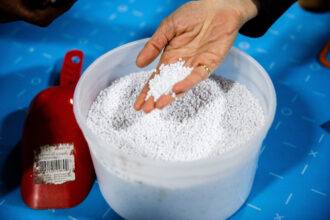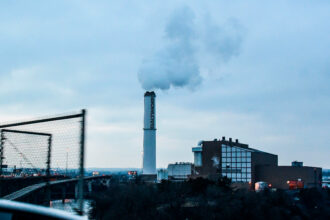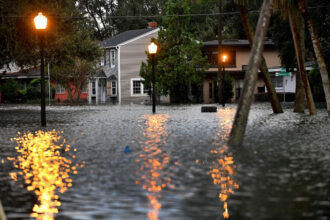Within a year of moving to Cherry Hill, a majority Black neighborhood on Baltimore’s southern tip, Shanae Thomas noticed her asthma—a health problem she was born with—had gradually worsened.
A 31-year old African-American woman and Baltimore native, Thomas moved to Cherry Hill in late 2019 because of family ties to the neighborhood and to gain more living space for her 8-year-old daughter, Chanel, and 13-year-old son, Devin.
“The aggravated asthma got to the point where I was waking up in the middle of the night gasping for air,” said Thomas, adding that it happened despite her following the precautions her doctor would advise such as taking allergy medicine, avoiding exposure to smoke and monitoring inhaler dosage.
“It was a mystery to me what was going on,” she said, until last October when a member of a local advocacy group knocked at her door and handed her a brochure about the trash incinerator spewing toxic contaminants and air pollution not far from where she lived.
“I was shocked because I never knew this incinerator was there the whole time I was living in Baltimore,” Thomas said.
The shock from finding out there was a source of toxic air pollution so close to home that could also be a driver of her worsening asthma soon turned into anger. Thomas also worried what it could mean for her children’s wellbeing.
“And once I learned that I was funding this pollution through my utility bills, I became extremely upset because it felt I was paying for my demise,” she added, her voice noticeably agitated.
Trash incinerators, like the one in Baltimore off Interstate 95, emit some of the most toxic pollutants with no safe level of exposure such as lead, mercury, nitrogen oxides and sulfur dioxide, which can trigger and worsen asthma symptoms.
Also called “trash-to-energy” facilities, they release hundreds of thousands of tons of climate-warming carbon dioxide every year in addition to PM2.5—extremely small particles that get into blood and lungs.
In 2011, Martin O’Malley, Maryland’s former governor and a Democrat, signed legislation declaring the electricity generated from burning trash a “tier one” renewable energy, making it eligible for public subsidies through the state’s clean energy credit system.
In late 2020, authorities signed a 10-year contract extension with Wheelabrator, the operator of the Baltimore incinerator, even though the facility is the city’s single largest standing source of air pollution. Consequently, the South Baltimore communities near the incinerator are asthma hotspots and have disproportionally high hospitalization rates, according to Progressive Maryland, a nonprofit group campaigning against trash incineration.
In the following weeks and months, Thomas learned about dozens of cases involving respiratory ailments in and around her neighborhood. The realization prompted her to join Progressive Maryland as an activist and add her voice to the chorus of demands to end subsidies for the trash-to-energy industry.
On March 1, Thomas joined scores of advocates and environmentalists from several Maryland-based community groups and nonprofits in front of the Thurgood Marshall statue in State House Square for a rally, calling on state legislators to get behind legislation that will remove trash incineration from the state’s renewable portfolio standard (RPS).
A similar bill seeking to remove trash incineration, factory farm gas and woody biomass from the state’s RPS failed to pass last year. This year, the bill is only focused on removing trash incineration and the advocates were cautiously hopeful about its passage.
About 25 percent of Maryland’s “clean” energy came from those sources in 2020 and their elimination from the RPS is considered crucial for meeting the state’s goal of 100 percent clean energy by 2035.
“We’re looking for Gov. [Wes] Moore to take a public stance in support of this legislation and show that he stands by the recommendation of the state’s Climate Pollution Reduction Plan, which specifically recommends this legislative action,” said Jennifer Kunze, Maryland director for Clean Water Action, a nonprofit advocacy group.
Moore has not yet committed to supporting the legislation. “The governor looks forward to reviewing legislation that passes through the state legislature this session. When bills hit his desk he will thoroughly review them all to ensure that the Moore-Miller Administration is enacting legislation that is in the best interest of all Marylanders,” said Carter Elliot, press secretary for the governor’s office in an emailed comment.
“I called the governor’s office to ask what their position was, and I was told they don’t have a position. So, it’s not a priority of the governor’s,” said Sen. Karen Young (D-Frederick County), the sponsor of the bill in the Senate.
There was “certainly an appetite” among legislators to move the bill, Young said, adding that the bill has been in the General Assembly for a number of years and been through many compromises. “Last year, there were three items in the bill. We narrowed it down to just one. But we will see.”
Young added that the full Senate will consider the proposal if the House moves the bill, which has to happen before March 18, the deadline for either of the chambers to send the bill to the other.
A Lingering Struggle
A 2019 report by the Maryland Power Plant Research Program found that the Maryland RPS could only manage “modest greenhouse gas reductions” and, more worryingly, “may be working at cross-purposes with the state’s efforts to reduce nitrogen oxides (NOx) and sulfur dioxide (SO2) emissions,” because of the inclusion of trash incineration.
“It’s time to finally put it to rest. But we are not seeing much action on environmental justice issues this year from the Moore administration,” Kunze lamented. This bill is not about shutting down incinerators, Kunze said, but calls for ending millions of dollars in subsidies for waste-to-energy facilities.
The bill already had a Senate hearing five weeks ago, Kunze said, and should now be scheduled for a vote. She urged Sen. Brian Feldman, who chairs the Senate Committee on Education, Energy and Environment, to put the bill to a vote and also asked the Senate President Bill Ferguson to support the legislation.
Feldman’s and Ferguson’s offices did not respond to multiple requests for comments about their respective positions with regards to the bill and obligation to constituents.
Feldman and Ferguson represent districts in Montgomery County and Baltimore City, where two of the three incinerators that participate in the subsidy program are located.
On Jan. 25, more than 80 community and advocacy groups submitted written testimony to the
Senate Committee on Education, Energy and Environment urging them “to stop wasting Maryland residents’ money” and use public subsidies to fund real renewable energy instead.
“We don’t want to fund trash incinerators at our doorstep. It’s hurting us.”
The testimony referenced a 2023 study in PLOS Climate, which found that “incinerators emit more greenhouse gas emissions per unit of electricity produced than any other power source – even coal plants.” Quoting the EPA’s emissions inventory, the letter said that in 2020 the three incinerators pocketing the state subsidy emitted 2.5 million tons of CO2 into the atmosphere.
Thomas and other advocates who gathered on March 1 had been talking about the urgency to public dollars for the three incinerators operating in the state.
In her right hand, Thomas held a folder containing 60 letters she had gathered from South Baltimore residents living with inflamed respiratory illnesses, describing their ordeal for the lawmakers to consider as they weighed their decision on the bill.
“We want Senate President Ferguson to understand how important it means to us as his constituents. He needs to notice our pain. We don’t want to fund trash incinerators at our doorstep. It’s hurting us,” Thomas said, as she made her way to his office.
Upon learning Ferguson was not available, she handed the letters to his staff. “I’ll be back for the next hearing on March 7,” she said, referring to the upcoming House Economic Matters Committee hearing scheduled to take up the house equivalent of the Senate bill.
Exorbitant Cost of Dirty Energy
Maryland is poised to dole out more than $300 million to trash incinerators between 2012 and 2030, according to the latest analysis by the nonprofits Public Employees for Environmental Responsibility (PEER), Clean Water Action and Progressive Maryland.
Under Maryland law, electricity providers can buy “Renewable Energy Credits” (RECs) sold by trash incinerators and pass the costs of those credits on to consumers in their energy bills. RECs are issued when one megawatt-hour (MWh) of electricity is generated and delivered to the grid from a renewable energy source.
Between 2012 and 2022, the study found, Maryland energy providers spent around $100 million on these credits, and that amount is expected to rise to $200 million between 2023 and 2030.

The data also showed that in 2022, the most subsidy dollars went to Virginia-based company Covanta, which owns and operates a trash incinerator in Lorton, Virginia, and pocketed $11.7 million through the sale of RECs. The Montgomery County government received about $8.7 million in subsidies and WIN Waste Innovations, which owns and operates the Wheelabrator incinerator in Baltimore, received about $4.2 million through the sale of RECs.
The analysis also showed that the participating trash incinerators emitted more CO2 per megawatt-hour than any other energy sources included in the RPS. Among the facilities operating in Maryland, the Wheelabrator incinerator in Baltimore City emitted the highest amount of planet-warming CO2, estimated at 690,033 tons of CO2 per year.
In the past 10 years, the report said, the price of RECs sold by trash incinerators increased more than seven-fold. They are now more expensive than RECs affiliated with wind, a clean, renewable energy source.
The authors of the study drew attention to the Maryland Department of the Environment’s Climate Pollution Reduction Plan (CPRP), which explicitly recommended removing trash incineration from the RPS. The Maryland Commission on Climate Change said the same in its 2023 report, the study noted.
“If the General Assembly acts now to eliminate trash incineration from the RPS, these hundreds of millions of dollars can instead be used to support clean energy projects that create increasing amounts of clean energy with greater benefits to Maryland consumers and help fight climate change,” the report said in one of its conclusions.
Timothy Whitehouse, executive director of PEER, the nonprofit which led the analysis, said that the report highlights the economic and environmental folly of having dirty trash incinerators in the state’s RPS.
“This report shows that it makes no sense that the RECs from dirty incinerators are more expensive than wind energy RECs, which represent real clean energy,” Whitehouse said.
He added that the estimated $200 million in public subsidies between 2023 and 2030 for trash incinerators is an underestimate because the prices of the RECs reported by the Maryland Public Service Commission (PSC) do not reflect the costs passed on to the consumer.
This raises accountability concerns, which, Whitehouse said, would be better addressed if the agencies such as PSC had adequate resources. “Unfortunately, in Maryland, there have been increasing levels of responsibility given to government agencies on clean and renewable energy programs. But not enough resources for them to monitor whether those programs are being implemented.”
For example, Whitehouse said, the PSC is very underfunded and there’s only one person that works on monitoring Maryland’s RPS program. “It’s a complex program with a huge number of compliance issues associated with it that are well beyond the scope of one person,” he said.
The current legislative session is critical in enabling the state’s regulatory agencies to better monitor the programs that have direct bearing on the state’s climate and clean energy targets, he added.
A Test of Legislators’ Will and Advocates’ Patience
On Thursday, March 7, Thomas was back in Annapolis to witness the House Economic Matters Committee hearing that was scheduled to take up the bill proposing to cut trash incineration from the state’s RPS.
From time to time, she would clutch at the inhaler tucked into the front pocket of her bag—a habit she said she’d developed over years of dealing with asthma attacks.
A number of written testimonies from advocacy groups and officials also dropped ahead of the committee hearing urging the lawmakers to consider the bill favorably in view of the cost to the public and cumulative health impacts for the communities living close to these waste-to-energy facilities.
“No source of energy that pollutes the air we breathe should be considered renewable.
The BRESCO trash incinerator pollutes the air we breathe in District 46 and throughout the city every single day,” said the letter signed by 12 community groups and nonprofit organizations working in South Baltimore.
This story is funded by readers like you.
Our nonprofit newsroom provides award-winning climate coverage free of charge and advertising. We rely on donations from readers like you to keep going. Please donate now to support our work.
Donate NowThe advocates argued that subsidizing trash incineration made it harder for local governments to transition to alternative and better forms of waste management such as composting, recycling, reuse and waste reduction initiatives and businesses.
In his letter to the committee members, Baltimore City Fourth District councilmember Mark Conway said incinerators like Wheelabrator’s emit dangerous pollutants such as mercury and dioxins, “contributing to cancer, heart disease, lung disease and more negative health outcomes in Baltimore City and the region.”
Co-signed by 11 other council members, the letter said the residents do not want to be forced to subsidize the incinerator that is polluting the air they breathe and continues to emit contaminants with no safe exposure limit at any level.
“We should support new rooftop solar and brownfield solar development here in Baltimore City” instead of throwing away money on trash incinerators like Wheelabrator, which, the letter said, “operated profitably for a quarter century before Maryland put trash incineration in Tier 1 of its RPS.”
Alice Goldberg, a Baltimore City resident, was next to testify before the committee. “Today, I want to tell you the story of a frontline community member, Shenae Thomas, who lives near the BRESCO incinerator in South Baltimore,” Goldberg said in her opening remarks.
She told the committee that she felt distressed when Thomas told her a month ago that her lungs hurt when she goes outside and that she could not trust the air enough to take a deep breath. “She also wants you to know that she feels exploited and upset knowing that Maryland’s dedicated renewable energy funds go into the pocketbook of a company that pollutes her community,” Goldberg added.
Thomas sat awash in mixed emotions hearing Goldberg describe her situation in an effort to convince the lawmakers to deliberate on the legislative proposal conscientiously.
“It’s frustrating. I feel some [lawmakers] are worried about what’s going to happen to the trash if this bill is passed,” Thomas said. ”A lot of times people don’t understand how impactful pollution is. They don’t think that it actually hurts people but it really does. And it’s frustrating that we have to make people understand that.”













